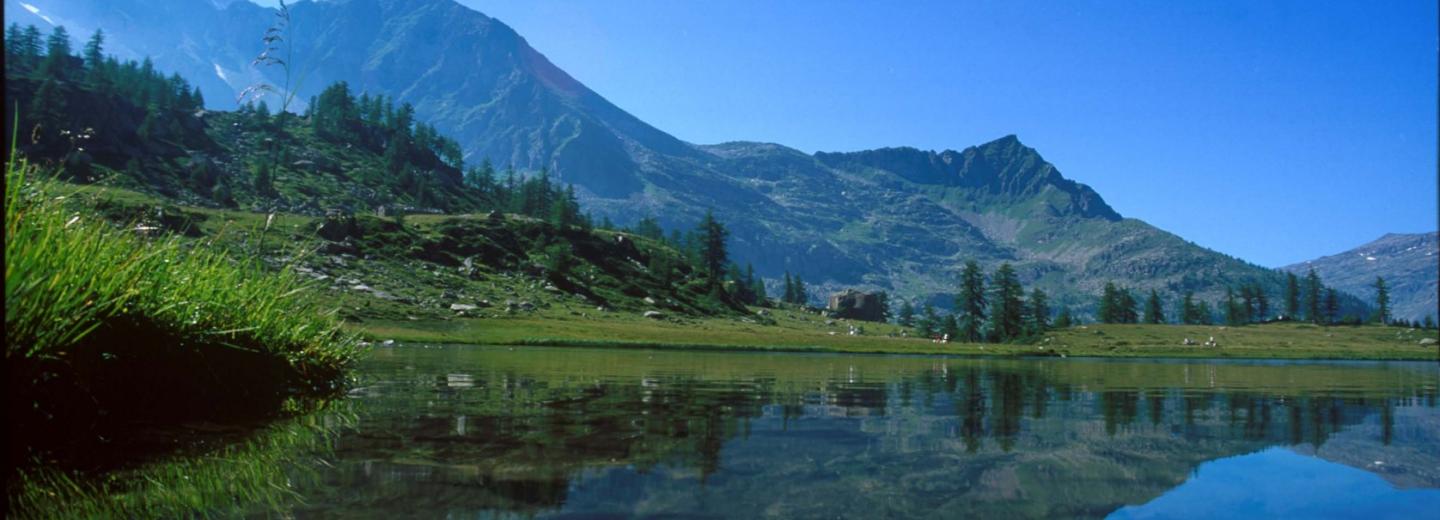Orco Valley among flavours and environment sustainability in an Alpine Pearl
The landscape of the Orco Valley is the one typical of glacial valleys where the modelling action of glaciers along millennia is clear, as the morphology, the rocky walls shape and the high altitude presence of glaciers and numerous ponds, created by melt water, witness. On this theme is focused the permanent exhibition of the Noasca Visitors Centre. The Nivolet Plateau from the landscape and naturalistic point of view is one of the most interesting plateau of the Alps, developed for over six km at 2500 m of altitude.
The whole Valley is crossed by the Orco stream for 47 km, that receives along his path numerous tributaries.
The Orco Valley is a real laboratory, is a place where traditions and culture of mountain people join summer and winter hiking with snow-shoes, cross-country skiing, climbing and other eco-friendly activities on open air, that can be practised only “on tip toe”, which means respecting the biological rhythms of the alpine fauna and flora.
From Cuorgnè head towards Pont Canavese and keep going towards Locana, village that has always been considered the “capital centre” of the Orco Valley for its position at the centre of the valley and for its commercial importance (is one of the widest municipalities in Italy with a surface of 13000 hectares). Locana is also “Honey City”, thanks to the ideal conditions for resident and nomadic bee-keeping founded here. A producer operator that since years “cultivates” this precious practice is without doubts the Marco Pezzetti bee-keeping.
For local delicacies a must-see place is the Laboroi Gastronomy while the Tarro Genta carpenter and Il Cantellino B&B are respectively suggested for woodworkings and as accommodation. For those who wish to make an excursion, from the Teleccio Lake, in 45-60 minutes, you'll reach the Pontese Hut, at 2200 m, behind which the Piana delle Muande opens surrounded by the great natural mountains amphitheatre such as Becco Meridionale della Tribolazione, Becca di Gay, Testa di Money, Gran San Pietro, punta Ondezana, Becco di Valsoera. All of them are over 3300 m high and international mountaineering destination.
Leaving Locana you'll reach Noasca, famous for the relationship it had with the King Vittorio Emanuele II: in 1856, indeed, the King declared Royal Hunting Reserve a part of the Noasca territory, saving the ibex from extinction. In Frera, gracious hamlet on the right side of the Orco stream, it's recommended a stop at the Osteria dei Viaggiatori that offers meat cooked on the stone, roses gnocchi and typical cheeses. As accommodation, instead, the ideal place is Il Maiolandro room rental, where you'll be able to find cromotherapy sauna, a small whirpool swimming pool with cromotherapy and the Himalayas salt cave.
If you want to buy tasting cheeses the alpine pasture La Gora farm, placed in the dairy situated at 2045 m high, under the Gran Piano royal house in the Noasca municipality (Ciamuseretto valley), is worth a visit.
Overtaking Noasca you'll reach Ceresole Reale, where the artificial Lake, prevails, it has been created by the dams built to generate electrical energy. Ceresole holds the adjective “Royal”, granted under the disposal of ancient hunting privileges to the King Vittorio Emanuele II. It has been the pearl of the 19th century tourism that inspired Carducci those lines of the famous “Ode to Piedmont” and has hosted the Queen Margherita that habitually spent her holidays here. From 19th century pearl in the XXI century it has become Alpine Pearl, for its environmental sustainability care. Here the offers for a nature and sustainable stay are different: Meublè Sport Hotel, Chalet del Lago Restaurant Hotel, Gli Scoiattoli Hotel, Hotel Blanchetti Restaurant Bar. The suggested Huts in Ceresole are: Massimo Mila, Guido Muzio and Le Fonti. Each of this Huts serve food following the tradition, as well as in Hotel Blanchetti, Chalet del Lago and Scoiattoli. Next to the Serrù dam, there is, instead, La Baracca Restaurant that offers genuine dishes of the territory.
For the campings interested ones there are also: Casa Bianca Camping and Piccolo Paradiso Camping. Particularly suitable for half-day snacks and for buying typical products we recommend the Lou Forn Bakery and the da Cristiana food shop. Special mention, finally, deserves the Marco Rolando sculpture atelier, ancient art of wood carving master – as well as ski instructor – within walking distance from the Lake.
